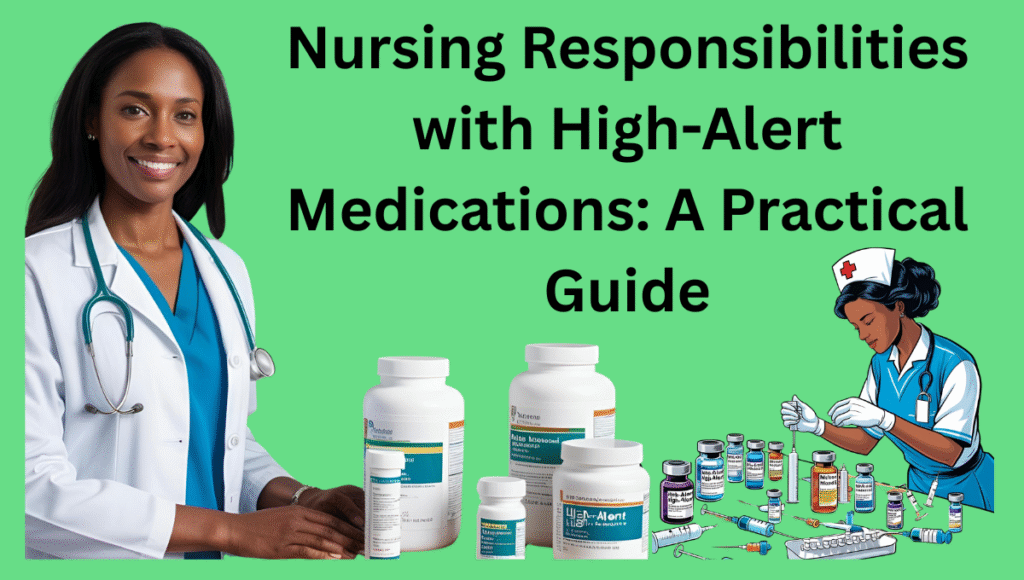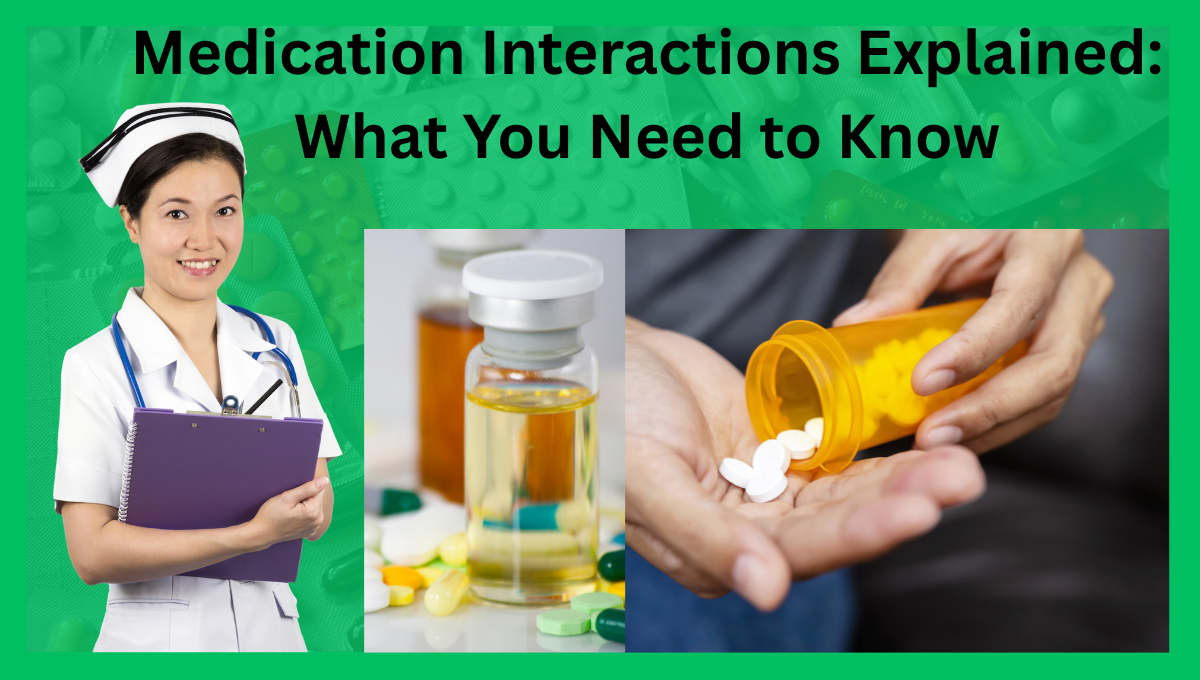Medication Interactions Explained: What You Need to Know
Introduction: The Significance of This Issue
Medication serves as a potent instrument for health and wellness; yet, the combination of several medications—be they prescription, over-the-counter (OTC), herbal, or supplements—can occasionally result in detrimental effects. Therefore, comprehending pharmaceutical interactions is crucial. This tutorial elucidates the subject in accessible language, detailing the reasons for interactions, methods to identify them, and strategies to ensure safety. Prepared? Let us commence!

1. What Are Medication Interactions?
A. Fundamental Definitions
Drug-Drug Interactions: The phenomenon wherein many drugs influence one another’s activities or effects.
Drug-Food Interactions: The impact of specific foods on the efficacy of a drug.
Drug-Supplement Interactions: The interference of herbal remedies, vitamins, or supplements with a drug.
2. What Causes Medication Interactions?
A. Fundamental Reasons
Absorption: Certain medications inhibit or postpone the absorption of others.
B. Metabolism: Numerous pharmaceuticals rely on hepatic enzymes, such as CYP450 enzymes. If one medicine accelerates or inhibits these enzymes, the concentrations of the other drug may fluctuate accordingly.
C. Elimination: Certain medications can influence the renal clearance rates of other drugs.
D. Pharmacodynamic Effects: Modifications in medication that amplify or negate one another’s effects (such as elevated blood pressure or excessive sedation).
3. Illustrations of Typical Interactions
A. Drug-Drug Interactions
NSAIDs with Antihypertensive Medications: Ibuprofen may diminish the efficacy of ACE inhibitors or diuretics and potentially exacerbate renal stress.
SSRIs and NSAIDs both act as anticoagulants, elevating the risk of hemorrhage.
Warfarin with Antibiotics: Certain antibiotics, such as ciprofloxacin, impede warfarin metabolism, hence increasing the risk of bleeding.
Antibiotics with Antacids: Antacids that contain aluminum or calcium may chelate antibiotics, thereby diminishing their efficacy.
B. Drug-Food Interactions
Grapefruit and Statins: Grapefruit inhibits CYP3A4 enzymes. Administration of statins such as atorvastatin or simvastatin may result in elevated levels, potentially causing myalgia or hepatic strain.
Leafy Greens & Warfarin: Foods rich in vitamin K (such as spinach and kale) may diminish the efficacy of warfarin.
Consumption of tyramine-rich foods, such as aged cheeses, cured meats, or soy sauce, in conjunction with MAOIs may lead to perilous elevations in blood pressure.
C. Drug-Supplement Interactions
St. John’s Wort with Antidepressants: Enhances the metabolism of various medications, including contraceptive pills.
Ginkgo with Anticoagulants: Elevates the risk of hemorrhage when used concurrently with warfarin, aspirin, or nonsteroidal anti-inflammatory drugs (NSAIDs).
Calcium supplements and antibiotics: May diminish antibiotic absorption.
4. Who Is at Elevated Risk?
Individuals on several medications, particularly the elderly or those with chronic ailments
Individuals use dietary supplements or natural medicines
Individuals with hepatic or renal disorders
Individuals utilizing drugs with a limited therapeutic index, such as digoxin or warfarin
Individuals amalgamating over-the-counter drugs or prescriptions from various providers
5. Indicators of Potential Interaction
Unforeseen adverse effects such as vertigo, gastrointestinal distress, or cephalalgia
Deterioration of your condition
Indicators of overdose: profound sedation, disorientation
Symptoms such as abrupt epistaxis, ecchymosis, or darkened urine (indicative of hemorrhage)
Arrhythmias or uncontrolled hypertension
If anything seems amiss, contact your pharmacist or physician—do not delay.
6. Strategies for Ensuring Safety
A. Maintain a Current Medication List Incorporate all pharmaceuticals, doses, and administration regimens. Remember to include over-the-counter medications, vitamins, and herbal supplements.
B. Utilize a Sole Pharmacy
Pharmacies can verify interactions among all the medications you are currently using.
C. Inquire, “Which foods should I refrain from consuming?”
“Will this have interactions with my other medications?”
“Should I consume this with food or on an empty stomach?”
D. Examine the Labels Labels frequently provide essential warning information—do not disregard them.
E. Utilize Dependable Pharmacological Interaction Resources
Premium websites or pharmaceutical applications can promptly identify potential concerns.
7. Practical Situations and Their Management
A. Scenario: Administering Ibuprofen for Cephalalgia
Possible Hazard: Decreases blood pressure regulation, perhaps stressing the kidneys
Recommendation: Consult your physician regarding alternatives such as acetaminophen, or consume it with food and hydrate adequately.
B. Scenario: Initiating St. John’s Wort
Potential Risk: Diminishes efficacy of contraceptives or antidepressants
Consult your provider prior to initiating herbal therapies.
C. Scenario: Administration of Warfarin Concurrently with a New Antibiotic Potential Risk: Elevated Hemorrhagic Risk
Healthcare practitioners will assess INR levels and modify the dosage as necessary.
8. Protocols for Managing Interactions
Remain calm!
Contact your provider promptly if the consequences are severe or unforeseen.
Detail the complete information—specify the medications administered, the timing of their intake, and your subsequent feelings.
Adhere to their instructions—this may entail discontinuing one medication or modifying the dosage.
Remain alert—observe for symptoms following adjustments.
9. Preventing Interactions: A Proactive Checklist
| Preventive Step | Why It Matters |
|---|---|
| Maintain an accurate meds list | Helps all providers see the full picture |
| Communicate openly with your care team | They can recognize risky combinations |
| Stick to trusted pharmacies & apps | Automates safety checks |
| Understand each drug’s guidelines | Know when and how to take each medication correctly |
| Be cautious with new OTCs or supplements | Share them with providers first |
10. The Function of Your Healthcare Team
Pharmacists are specialists in pharmaceuticals—consult them for guidance.
Physicians consider your individual health requirements.
Nurses and assistants ensure proper usage and identify concerns.
You are the pivotal participant—remain informed, ready, and anticipatory.
11. Debunking Myths: Prevailing Misconceptions
“They are merely vitamins; they pose no harm.” Incorrect—high-dose vitamins may interact, such as vitamin E with anticoagulants.
“Over-the-counter medications are invariably safe.” Both Benadryl and antacids may induce complications.
“Absence of side effects indicates lack of interaction.” False—certain interactions develop gradually or do not exhibit symptoms immediately.
12. Current Trends in Drug Interaction Awareness
Medication Synchronization Programs: Facilitate the simultaneous administration of all medications, hence streamlining the process.
Genetic Testing (Pharmacogenomics): Adjusts medication selections and dosages according to your metabolic profile.
Smartphone Interaction Applications: Deliver immediate notifications to your device
13. Conclusive Insights
Medication interactions are prevalent yet tolerable.
Ensure all parties are informed of your actions.
Leverage the capabilities of pharmacies and technology for enhanced safety.
Articulate your concerns: inquire, disclose symptoms, and adhere to expert recommendations.
14. Subsequent Actions You May Undertake
Create your medicine list today—either digitally on your phone or manually on paper.
Disseminate it to your physician or pharmacist.
Investigate reputable applications such as Drugs.com or the application provided by your pharmacy.
Inquire—no inquiry is insignificant when your safety is at risk.
15. Commonly Asked Questions (Concise)
Q: Is it permissible to combine over-the-counter medications with prescription drugs?
A: Proceed only with your healthcare provider’s approval—exercise particular caution.
Q: What is the expected duration before the effects of a drug interaction manifest?
A: The duration varies; it may be immediate or extend from days to weeks, based upon metabolism and timing.
Q: Is grapefruit the sole food of concern?
A: Certainly—leafy greens, meals high in tyramine, and dairy products can induce complications.
16. Subsequent Item on Your Agenda
Remain attentive for forthcoming posts:
“A Comprehensive Review of Drug Interaction Applications”
“Culinary Safety: Edibles Compatible with Common Medications”
“Beyond the Bottle: The Actual Mechanisms of Supplement Interaction in the Body”
Conclusion.
Medication interactions need not be alarming. Equipped with the appropriate information, resources, and assistance, you will maintain control. Utilize this guide to enhance your understanding—employ that knowledge to inquire, be vigilant, and assume control of your health.

